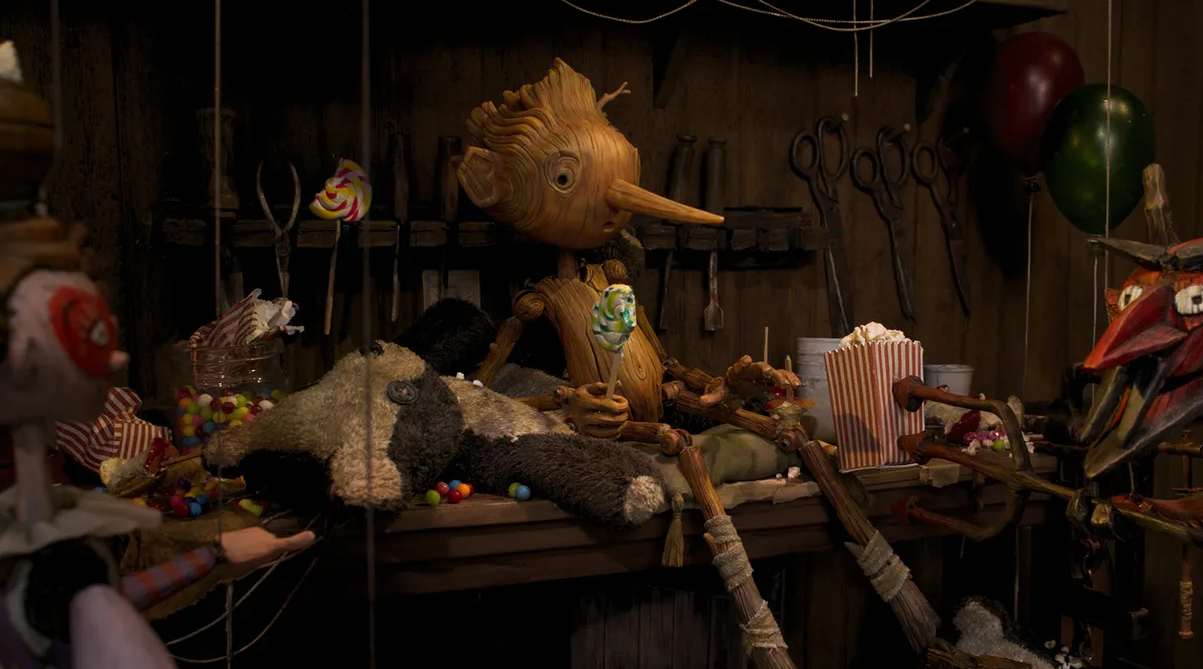Guillermo del Toro's PINOCCHIO is made with intricacy and care
Written by Guillermo del Toro (screenplay & screen story), Patrick McHale (screenplay), Matthew Robbins (screen story) and Carlo Collodi (characters and novel)
Directed by Guillermo del Toro and Mark Gustafson
Starring Gregory Mann, Ewan McGregor, Ron Perlman, Finn Wolfhard, and Cate Blanchett
Running time 1 hour and 57 minutes
In theaters Friday and on Netflix December 9
by Rosalie Kicks, Editor in Chief and Old Sport
“It’s a house of horrors!”
Guillermo del Toro’s and Mark Gustafson’s Pinocchio is yet another confirmation that I have made the appropriate decision to never have children.
Set in Italy during the 1930s when Benito Mussolini and the National Fascist Party were running amok, a sweet elderly gentleman named Gepetto (David Bradley) and his affable son Carlo live in a precious cottage on the outskirts of a quaint village. After an unfortunate accident caused by the country’s unrest, Carlo suffers a tragic demise leaving behind his devastated and broken father. This event causes the once imaginative and tinkering Gepetto to spiral, losing all sense of himself as he drowns his sorrows in liquid courage. After a night of debauchery, Gepetto finds himself at the end of his rope but instead of doing something morbidly drastic he decides to transfer his grief into creativity. He chops down a tree that had been planted after Carlo’s death and transforms it into a wooden specimen that can fill the void of the one he dreadfully lost. Unbeknownst to Gepetto is that a demure insect by the name of Sebastian J. Cricket (Ewan McGregor) had taken home within the confines of the sapling in hopes to complete his memoir. When Gepetto awakens from his drunken slumber he finds, much like Frankenstein’s monster, the once inanimate creature is now alive!
During the pale moonlight, Gepetto’s wooden child was visited by a celestial being (Tilda Swinton). She provides them with the name Pinocchio and grants them the opportunity to live. Additionally, while remaining safely tucked inside the boy’s heart, she appoints Sebastian to serve as the boy’s guardian. Essentially, Sebastian is concerned about the overall safety of his home, which can be achieved by keeping the boy from mischief.
I am sure the top of mind question from everyone and anyone is: Did we need another Pinocchio? Simple answer: No. However, I would like to point out this is not just any Pinocchio film, this is instead a creation from the mind of Guillermo del Toro. I find this specific fact to be the main point of contention if one is attempting to lump this into the cinematic scrap pile. Much like Gepetto, Guillermo’s productions are often made with such intricacy and with such a care that it begs the question if there has ever been a motion picture like such before it. The craftsmanship and exquisite detail that went into each frame of this animated picture is marvelous. Anyone that successfully makes it out of this film without wanting to procure a small Pinocchio of their own should be concerned whether they have a pulse of not. This is a film worth leaving your sofa for and watching in your local movie palace.
Dark moments emerge throughout the almost two hour tale and, at times, it verges into a creepy realm. It is learned that although Pinocchio is alive, he is immortal. Even so, he still has several brushes with Death (Tilda Swinton). Despite the lead-up to these moments being grim, del Toro manages to make them somewhat amusing through the teachings Death provides to the moppet. Ultimately these sessions of enlightenment prepare him for a decision he will make in the future. Upon sitting down with my thoughts about the film, I realized that the overall dark mood and atmosphere work so well for this particular tale. At the focal point of the tale is misery, mourning and the idea of acceptance. Unlike Dr. Frankenstein assembling a creature for the purpose of vanity, Gepetto’s was made in hope to mend a broken heart. There is an attempt to revive his past life, a life filled with joy. Instead, by not attempting to move forward, he has shrouded himself in sadness.
The relationship between Pinocchio and Gepetto is not instantly sunshine and rainbows. Before Gepetto is able to make to the light, he first needs to travel through the darkness. He fails to realize that Pinocchio is not a replacement for what he has lost, but instead a new beginning. This leads to him rejecting the young lad, which in turn causes Pinocchio to make some unwise decisions such as, running away to the carnival with sleaze merchant Count Volpe (Chistoph Waltz) and his monkey pal, Spazzatura* (Cate Blanchett).
It is hard not to crack a smile while watching the fish out of water that is Pinocchio. The character exudes energy and makes me believe this is what a kid with a full-on sugar rush is like. He is not immediately accepted by those around him, but is only aware of his differences when someone decides to articulate them to him. This does not deter Pinocchio from wanting to be himself, he instead is only more curious about the environment he has found himself in. This story managed to pull at my heart strings and serve as a reminder the importance of living in the present. There is a comfort in our past, but it should not be something that inhibits us from enjoying the now.
*Side note: Fellow MJer, Ashley Jane Davis got me thinking how interesting it is that Guillermo del Toro had one of the greatest living actors known on planet Earth to play a character in which their only lines are monkey sounds. That’s movie magic!


